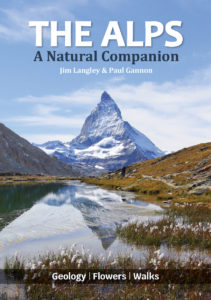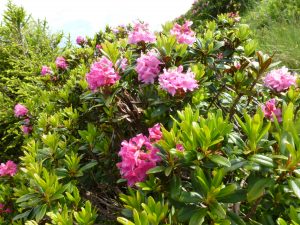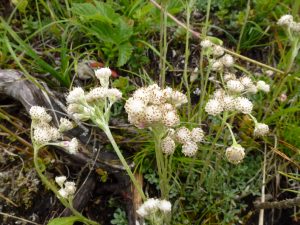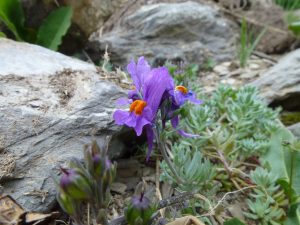The life of alpine flowers! The European Alps are renown for their biological diversity and are home to an estimated 650 truly Alpine species. They support many beautiful and distinctive plant species that are superbly adapted to the their specific habitats. The shear quantity and scale of alpine flowers is testament to the importance of cross-pollination, however, flowering and reproduction can be risky at high altitudes. As a result alpine plants have adopted a suit of alternatives in order to bypass these difficulties. These alternatives generally tend to increase in importance with increasing altitude.
The need to reproduce
The ultimate aim of all living things is to pass on their genetic material to future generations. The pressures of alpine environments, with short growing season, low air and soil temperatures, drying winds and low fertility soils, have resulted in a high frequency of long-lived clonal plants in alpine floras. As a result a variety of strategies can be seen in which alpine plants gain an advantage in colonising open ground and establishing in new habitats.
Sex, a conventional strategy
The life of alpine flowers! The evolutionary advantage of sexual reproduction by recombining the genes of two parent plants in their offspring has clear benefits for the long-term adaptation and survival of a species. Plants also have the ability to self-pollinate which has its benefits in extreme environments however it can cause inbreeding and lead to reduce reproductive success. So a preferred option is for cross-pollination with most alpine plant pollinators being insects. These include flies, bumblebees, short-tongued bees, butterflies and moths.
Sexual reproduction is very energy expensive for a plant and far more pollen and seed are produced than is ever used. Pollination is often unreliable in extreme environments where few pollinators exist; bumblebees for instance will only fly when the air temperature is above 10°C and are generally found pollinating plants at lower alpine levels.
 Alpine flowers have evolved with many having bright colours and large in size. This has many benefits in attracting pollinators but also they also play an important role in the development of seeds as they trap solar energy, acting like a parabolic satellite dish focusing the suns rays. Some alpine plants, such as Mountain avens and Glacier crowsfoot, track the sun as it arcs across the sky maximising solar radiation in a method known as ‘heliotropism’.
Alpine flowers have evolved with many having bright colours and large in size. This has many benefits in attracting pollinators but also they also play an important role in the development of seeds as they trap solar energy, acting like a parabolic satellite dish focusing the suns rays. Some alpine plants, such as Mountain avens and Glacier crowsfoot, track the sun as it arcs across the sky maximising solar radiation in a method known as ‘heliotropism’.
You can expand on this article by reading my book The Alps a natural companion
Alternative strategies
Plants can reproduction without sex in a method known as asexual reproduction which they do in two main ways. They either produce an identical clone of themselves (vegetative reproduction) or produce a seed without sexual fertilisation (apomixis). They essentially create an identical replica (clone) of the parent plant by forming a new plant fragment usually from the stem, root or leaf.
The diversity of strategies adopted and displayed by this form of reproduction is very prevalent in alpine plant communities. In some cases plants, such as Alpine bistort and Ladies mantle, use it exclusively. These strategies are a more efficient method of ensuring the long-term survival of the individual plant but may only play an important adaptive benefit in the short-term.
Clones, the secret to a long life
There are many methods of vegetative reproduction and it is estimated that at high altitudes more than 80% of all plants are clonal. Species that reproduce through non-sexual methods can grow to extremely old ages, even many thousands of years for example Moss campion. Some examples of clonal reproduction are highlighted below.
Tussock grasses (graminoids) such as Tufted Hair-grass (Deschampsia cespitosa) form dense clusters of shoots with new shoots appearing at one end.
Mat-forming herbs such as Mountain everlasting (Antennaria dioica) form clusters of non-woody rosettes which root as they spread out.
Plants producing runners (stolons or rhizomes) such as Alpine toadflax (Linaria alpine) send shoots which can be connected below or above ground and can spread quickly.
Creeping dwarf shrubs produce buds just above the soil from which a new clonal fragment with tiny roots appear. Trailing azalea (Loiseleuria procumbens) is a good example of this form of clonal growth.
Prostrate dwarf shrubs, such as Alpenrose (Rhododendron ferrugineum), have above ground branching stems. They produce new shoots from buds buried in new soil which produce tiny, adventitious roots. (see main image on page 1)
Accidental clonal plants, such as Glacier crowsfoot (Ranunculus glacialis), can reproduce clonally under certain circumstances but it is not their preferred method.
Vivipary in plants is a type of asexual reproduction where either the seed is replaced with a plantlet or alternatively a flower with a bulbil in the flower head. The detachable vegetative plantlets, which are spread like seeds, can establish immediately upon landing on a suitable habitat. Alpine bistort (Persicaria vivipara) produces reddish bulbils below white flowers.
Apomixis is the formation of a seed not involving fertilisation through pollination. Matt grass (Nardus stricta) has recently been discovered to demonstrate apomixis.
Learn more about alpine flowers and the natural world with a beautifully crafted pack of playing cards. This series of playing cards covers wildflowers, trees of Europe and alpine flowers. There are also wildflower Top trump cards to buy too. Top Trumps are the UK’s best selling card game! Visit our shop to buy








